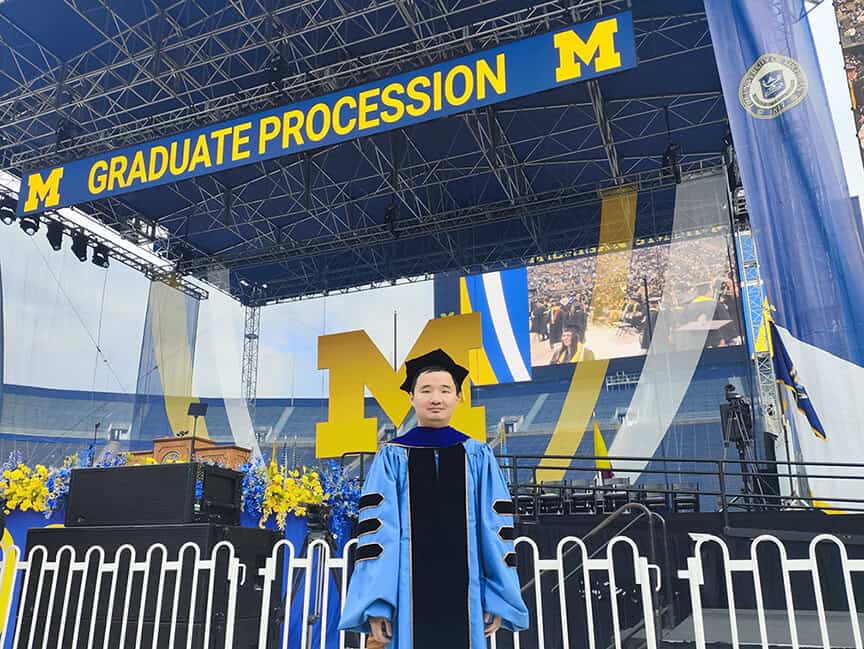
Fan Garners Prestigious ProQuest Distinguished Dissertation Award
For the first time in 16 years, an alumnus of the U-M Department of Climate and Space received a ProQuest Distinguished Dissertation Award.

For the first time in 16 years, an alumnus of the U-M Department of Climate and Space received a ProQuest Distinguished Dissertation Award.
Chongxing Fan, Ph.D., a 2024 graduate from the doctoral program at the University of Michigan Department of Climate and Space, has garnered an Honorable Mention in the prestigious ProQuest Distinguished Dissertation Awards from the Rackham Graduate School.
The ProQuest Distinguished Dissertation Awards recognize highly accomplished graduate students who have produced exceptional dissertations of outstanding scholarly quality in any field of study. Fan is the first student from the Department of Climate and Space Sciences and Engineering to be recognized in the competition in approximately 16 years.
During his doctoral program, Fan worked in Professor Xianglei Huang’s research group on topics related to atmospheric radiative transfer. Fan’s research interests include satellite data analysis, climate modeling, and machine learning applications in climate sciences. His past research experiences include aerosol-climate interactions during his undergraduate study at Nanjing University in China.
At the University of Michigan, he used satellite observations to quantify the changes in surface radiative properties due to the construction of solar farms. With support from the NASA FINESST Fellowship, he worked on modeling solar farms with a better physical representation in global climate models. In addition to studying climate and space sciences, he obtained a Certificate of Graduate Studies in Computational Discovery and Engineering in 2022.
Fan has published many papers, including “Strong Precipitation Suppression by Aerosols in Marine Low Clouds” in Geophysical Research Letters (2020) and “A Refined Understanding of the Ice Cloud Longwave Scattering Effects in Climate Model” in the Journal of Advances in Modeling Earth Systems (2023.)
Fan has received the ProQuest Distinguished Dissertation Award for the Ph.D. Dissertation Defense he gave in March 2024. The topic of his dissertation is “The Importance of Accurate Physical Parameterization for Radiative Transfer in Global Climate Simulations and Remote Sensing: Examples of Cloud Longwave Scattering and Solar Farm Modeling.” In his abstract, he discusses a series of studies and investigates two scenarios, including cloud longwave (LW) scattering and solar farm modeling, as they relate to radiation transfer, global climate simulations, and remote sensing technologies.
Fan is now working as a post-doctoral fellow in the Program of Atmospheric and Oceanic Sciences at Princeton University.
Congratulations, Dr. Fan!
Read the Abstract:
Radiation plays a critical role in Earth’s climate system and the satellite remote sensing of the climate system. Yet, our parameterization of radiative transfer is still filled with assumptions and approximations. This series of studies aims to investigate two examples, cloud longwave (LW) scattering and solar farm modeling, to emphasize the importance of reducing uncertainty in radiative transfer through better physical representation.
Most climate models ignore cloud scattering in longwave radiative transfer. Here, the impact of ice-cloud longwave scattering on the fully coupled climate system is evaluated in the Energy Exascale Earth System Model (E3SM). Instantaneously, the inclusion of ice-cloud longwave scattering reduces the outgoing longwave radiation (OLR) by 1 W/m2 on the global average and 2 W/m2 on the tropical average. After the fast and slow adjustments of the whole climate system, the global mean temperature increases by 0.66 K compared to the simulation without longwave scattering. Strong Arctic warming is evident in the results, which is part of the global response to radiative perturbation rather than a local impact of LW scattering. Including ice-cloud LW scattering does not significantly affect the simulated responses to abrupt 4×CO2 increases. In addition, based on a combination of two-stream analytical solutions, Monte-Carlo simulations, and offline radiative transfer calculation with actual sounding profiles, it is shown that cloud scattering can provide signals useful for remote sensing applications even in an isothermal environment.
While extensive coverage of solar panels can generate renewable energy and thus reduce carbon emission, these panels modify surface radiative and aerodynamic properties, resulting in local and potentially remote effects on the climate system. However, previous modeling studies drew different conclusions due to different assumptions, lack of observational constraints, and crude parameterizations of the radiative transfer in the presence of solar panels. First, satellite observations are utilized to track multiple solar farms in the southwestern U.S. from the top of the atmosphere. The decrease in surface reflectance and consequent reduction in reflected shortwave radiation is robust over different solar farms, although aerosols and thin cirrus can contaminate the results. The retrieval of surface emissivity and temperature presents a challenge as the algorithm fails to account for the low surface emissivity of solar panels. Nevertheless, results consistently show that outgoing longwave radiation is reduced during the day with negligible changes observed during the night. Next, a solar farm model is developed and implemented into the Community Land Model (CLM) version 5.0. A 2D Monte Carlo model is built to simulate radiative transfer within the solar farm. Solar panels and the bare ground beneath them are treated independently with their own temperatures and radiative properties. Non-radiative fluxes are also computed in resemblance to the canopy model in CLM5.0. Hourly outputs from the scheme are validated against previous in-situ measurements. Finally, pairs of fully coupled global climate simulations are conducted using the modified CLM5.0 in Community Earth System Model version 2.1.3, which includes the new solar farm model. Analyzing the last 10 years of simulations reveals that a large solar farm deployed in the Sahara Desert could induce local warming by 4 K, leading to an increase in convection and, consequently, an increase in cloud cover and precipitation. Sensitivity experiments are carried out to evaluate the impact of solar farms at different locations and under different scenarios.